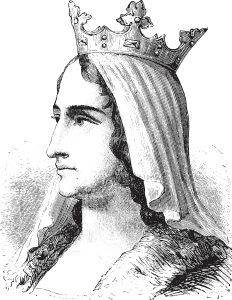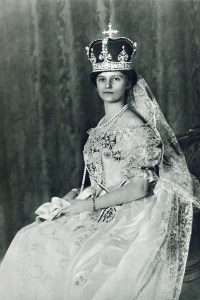Across borders and time zones, the Sept. 8 death of Britain’s Queen Elizabeth II prompted global expressions of public mourning that are rarely seen. And understandably so: The long-serving queen was no ordinary monarch, and her passing has renewed popular interest in her life and the history of the British monarchy.
Though not Catholic, Elizabeth’s reign exemplified a level of duty in the service of her country that persons of any religion should find admirable. Her sincere Christian faith was evident to those who knew her, and over the course of seven decades, she showed how a successful queen can become a potent national symbol.
The Catholic tradition is replete with examples of such monarchs: women who led their people through the most difficult of times, who saw their royal status as part of a divine vocation. Here are five exemplars of Catholic queenship worth knowing.

St. Helena (250-330)
Any discussion of Catholic queenship has to begin with St. Helena, the queen mother of Emperor Constantine and spiritual matron of all future Christian queens.
Helena’s origins are obscure; she was born of a pagan family in what is today northern Turkey. In her youth she was a “stabularia,” which may mean “stable maid” or “innkeeper.” She met and attracted the attention of the military officer Constantius Chlorus. Constantius was smitten with Helena and took her as his lover. Helena’s exact relation with Constantius is uncertain; some say she was his lawful wife; others his common law wife, or perhaps concubine. Around 272 she bore Constantius her only child, Constantine, the future emperor.
By 289, Constantius’ fortunes were on the rise. The new emperor, Diocletian, had elevated him to co-regent of the western empire. Constantius subsequently divorced Helena to marry a noblewoman more becoming of his stature. Helena was sent off to live with her son, Constantine, who was serving in the imperial court. Constantine took in his forsaken mother with tenderness, always reverencing her.
When Constantius died in 308, Constantine assumed his father’s office in the west. He summoned Helena to his court and gave her the title “Augusta” (“Empress”). By 313, Constantine had become sole emperor of the west and embraced Christianity. The zeal of his new faith had a deep impact on his mother, and Helena converted soon after her son.
Helena embraced her dual roles as Christian mother and “Augusta” with fervor. Though already 63 years of age at her conversion, it was in this latter phase of her life that she was most active, earning everlasting renown for her relentless good deeds.
Most Roman imperial mothers traditionally kept a low profile. Helena, however, traveled constantly, serving as the maternal face of the imperial throne and the new faith. Everywhere she went she constructed churches, in the east and west. Her lavish endowments in the Holy Land are well known; she funded the construction of the Church of the Nativity in Bethlehem and the Church of Eleona on the Mount of Olives at the sight of Christ’s ascension. Her discovery of the true cross in Jerusalem bestowed to the Church its most venerated relic.
To Helena fell the task of constructing the precedents of Christian queenship — endowing monasteries, funding churches, and becoming, in her person, an incentive to piety for her people. She was the first to show Christians the “human” face of the monarchy, balancing the administrative or “imperial” face represented by her son, the emperor. Wherever Christian queens are honored, St. Helena will always stand as matriarch.

St. Balthild, Queen of Neustria (626-680)
St. Balthild was queen of the kingdom of Neustria, corresponding roughly to today’s western France. Balthild’s life did not begin promisingly; at a young age she was sold into slavery and raised as a servant in the house of Erchinoald, a powerful Neustrian noble. Being beautiful and modest, Balthild soon attracted Erchinoald’s attention. The powerful lord pressured her to marry him, but Balthild refused, even resorting to physically hiding herself to escape his unwanted advances.
One day King Clovis II came to visit Erchinoald and noticed Balthild in his retinue. He was delighted with her beauty, intelligence, and modesty. The king freed her from slavery and asked for her hand in marriage. Clovis and Balthild were wed in 649. By age 23, Balthild had gone from slave to queen.
As queen she remained humble, modest, and devoted to charitable works. She founded abbeys and hospitals. Having come from servile origins, she had a profound detestation for the institution of slavery. Her favorite charity was securing the freedom of child slaves, and to this end no expense was too great. After the death of her husband (657) she ruled as regent for her young son. Once in charge, she abolished Christian slavery throughout Neustria, securing the freedom of untold thousands.
Balthild bore Clovis three sons; each would rule as king in turn. In her old age Balthild retired to a convent, where she insisted on being treated as the lowest of all the sisters, personally caring for the sick and poor for 15 years until her death in 680 at age 54.
Catholic history has many examples of saintly queens, but in leading her to better the lot of the lowest in her charge, St. Balthild’s sanctity stands apart.

St. Adélaïde of Italy (931-999)
St. Adélaïde was used as a political football almost from birth. The daughter of the king of Burgundy, she was betrothed at a young age, married at 16, widowed at 19, and imprisoned for rebuffing the machinations of a noble. Kept in solitary confinement at Lake Garda in northern Italy for months, Adélaïde was rescued by a priest who dug a subterranean passage to free her. For a time, the teenage princess lived in the woods surviving off fish caught from Lake Garda until she was rescued by a sympathetic duke who took her south.
She soon met King Otto of Germany in 951, whom she fell in love with and wed even though he was 20 years her senior. Adélaïde was beautiful and virtuous, exciting the universal admiration of her German subjects. She bore Otto four children, one of whom would become the Holy Roman Emperor Otto II.
Her profile rose in 962 when Pope John XII crowned her husband holy Roman emperor — and, in a break with tradition, Adélaïde, too, was crowned holy Roman empress. She was not a mere royal consort, but a co-bearer of royal authority, a “consors regni” (“partner in the rule”). As a Burgundian, Adélaïde was always extremely popular in Italy and used her influence to help solidify the rule of her husband among Italians.
Later, Adélaïde would be called to assume direct rule as regent for her grandson, Otto III. The minority of a monarch under a female regent was often a perilous time of political jostling and civil war, but Adélaïde kept a firm grip on the kingdom until her grandson came of age.
Her kindness, charitable works, and ceaseless efforts in support of converting the Slavs won her the praise of church and state alike. She died in 999 on the way to Burgundy to help her nephew reconcile with his enemies.

Isabella of Castile (1451-1504)
The famous daughter of John II of Castile was raised in a pious household and maintained her integrity despite the constant attempts of nobles and courtiers to use her as a political pawn in their dynastic intrigues.
As a young woman, Isabella was eagerly courted by nobility from all over western Europe. Her preference was for the young Ferdinand, heir to the throne of Aragon. Her father opposed the match, threatening to imprison Isabella should she disobey his wishes. While he was away, however, she escaped with the help of the Archbishop of Toledo and fled to Valladolid. There she wed Ferdinand of Aragon in 1469, assuming the queenship of Castile and Leon in 1574.
Thus began one of the most renowned reigns of Christendom. Few other monarch spouses are spoken of as a single unit the way we speak of “Ferdinand and Isabella.” Of course, Isabella is best remembered for her support of Columbus in his expeditions across the Atlantic.
But there was much more to her reign. Together with her husband, she enacted a series of sweeping reforms of Spain’s government. She promoted education and founded schools throughout the kingdom . As sovereign of Spain’s territories in the New World, she was a staunch defender of the rights of Native Americans, forbidding their enslavement and compelling the release of natives already enslaved. In her personal life, she was a model of virtue who, despite being a monarch of fabulous wealth and power, still personally mended her husband’s garments. During her life, Isabelle of Castile was known as “Her Most Catholic Majesty,” a title bestowed by Pope Alexander VI by papal bull.
Isabella not only changed the course of world history through her patronage of Columbus, but bettered the lives of her people on both sides of the Atlantic through her wisdom and example. Though she was never beatified, there has been a persistent cultus of Isabella in Spain. In 1974, Pope St. Paul VI recognized her as a Servant of God.

Empress Zita (1892-1989)
Though born to royalty, the life of Empress Zita of Bourbon-Parma was seldom easy. She was the 17th child of the dispossessed Duke of Parma. She was raised in Italy in a devout family, spending some of her youth in a convent. Zita was eventually wed to Archduke Charles Hapsburg of Austria in 1911, the second in line to the throne of the Austro-Hungarian Empire. The couple would have eight children over the next 10 years.
The assassination of Franz Ferdinand in 1914 placed Charles next in line for the throne, which he and Zita assumed in 1916 upon the death of Emperor Franz Joseph, during the Great War. The rest of Zita’s life would be defined by the events of World War I and their aftermath. Following Austria’s defeat and the collapse of the empire, Zita’s family went into exile but were unwanted wherever they went: Hungary, Switzerland, Malta, and France each refused the imperial residency, as they feared the political risks.
The family eventually settled on the Portuguese island of Madeira, where Charles died of pneumonia at age 34. Zita would live 67 years as a widow, wearing perpetual black in mourning for Charles.
At the outbreak of World War II, she and her family fled to the United States to escape the Nazis, eventually settling in Quebec. These years were very hard for Zita; the war made it difficult to access support from Europe; at one point the family was reduced almost to poverty. She spent the final years of the war touring North America to raise funds for rebuilding war-torn Austria.
After the war Zita returned to Europe. As law forbade her from residing in Austria, she took up residence in Switzerland, where she worked tirelessly to promote the canonization of her late husband. Zita died at age 95 in 1989, surrounded by her family. Charles would eventually be beatified by St. Pope John Paul II in 2004; Zita’s own cause was opened in 2009.
Like Elizabeth II, Zita continually placed duty above personal interest. The exile from her homeland, stripping of titles, repudiation of her family, and near destitution she endured did not stop her from advocating tirelessly for Austria throughout her long life.
. . .
Each of these royal women faced considerable obstacles: abandonment, slavery, imprisonment, and exile. Yet each extended their motherhood to all their people, becoming true beacons of unity for their people.
We may struggle to conceive of the state as anything but a cold bureaucracy. Perhaps the character of Elizabeth II fascinates us because she — and other historical queens — remind us that it need not be so.

